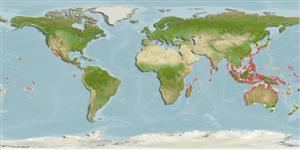Malacostraca |
Decapoda |
Palaemonidae
Environment: milieu / climate zone / تغييرات عمق / distribution range
بوم شناسي
وابسته به آب سنگ; تغييرات عمق 1 - 15 m (مرجع 113378). Tropical
Indo-Pacific: Mozambique to Japan, Australia and Papua New Guinea.
Length at first maturity / Size / Weight / سن
بلوغ: Lm ? range ? - ? cm
Body is transparent with large white spots. Four to five orange spots with a black ring are present on the tail fan. Purplish-blue rings are present near the joints and tips of pereiopods. Rostrum well-developed, with five to six dorsal, and two ventral teeth. Females are generally larger.
Minimum depth from Ref. 83472. Epizoic, Intertidal to subtidal (Ref. 106854). Associated with giant anemones (Ref. 113378). Usually found in pairs. Occasionally found on hard corals (Ref. 125532).
Life cycle and mating behavior
بلوغ | تولید مثل | تخم ریزی | Eggs | Fecundity | Larvae
Members of the order Decapoda are mostly gonochoric. Mating behavior: Precopulatory courtship ritual is common (through olfactory and tactile cues); usually indirect sperm transfer.
مآخذ اصلی
مراجع | هماهنگ كننده | همكاران
Bruce, A.J. 2005 Pontoniine shrimps from Papua New Guinea, with designation of two new genera, Cainonia and Colemonia (Crustacea: Decapoda: Palaemonidae). Memoirs of the Queensland Museum 51(2):333-383. (مرجع 83471)
وضعيت در فهرست قرمز IUCN
(مرجع 130435: Version 2025-1)
وضعيت از نظر سايتس (مرجع 108899)
Not Evaluated
Not Evaluated
خطر برای انسان ها
استفاده انسانی
| FishSource |
ابزارها
اطلاعات بيشتر
Trophic EcologyFood items (preys)
تركيب غذايي
مصرف غذايي
شکارچیان
Population dynamicsرشد
Max. ages / sizes
Length-weight rel.
Length-length rel.
نوسانات طولی
Mass conversion
فراواني
Life cycleتولید مثلبلوغFecundityتخم ریزیEggsنمو تخمLarvae PhysiologyOxygen consumption
Human RelatedStamps, coins, misc.
منابع اينترنتي
Estimates based on models
Preferred temperature
(Ref.
115969): 22.9 - 29.3, mean 28.3 (based on 3320 cells).
